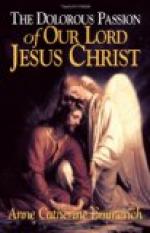The friend remembered having often seen this little Joseph playing on the bed of Sister Emmerich, and he supposed that she was dreaming about him on the previous day. When the friend went to see her later in the day to endeavour to obtain a continuation of the narrations of the Passion, he found her, contrary to his expectation, more calm, and apparently better in health than on the previous day. She told him that she had seen nothing more after the scourging of our Lord; and when he questioned her concerning what she had said about little Joseph, she could not remember having spoken of the child at all. He then asked the reason of her being so calm, serene, and apparently well in health; and she answered, ’I always feel thus when Mid-Lent comes, for then the Church sings with Isaias in the introit at Mass: “Rejoice, O, Jerusalem, and come together all you that love her; rejoice with joy, you that have been in sorrow, that you may exult and be filled from the breasts of your consolation.” Mid-Lent Sunday is consequently a day of rejoicing; and you may likewise remember that, in the gospel of this day, the Church relates how our Lord fed five thousand men with five loaves and two fishes, of which twelve baskets of fragments remained, consequently we ought to rejoice.’
She likewise added, that our Lord had deigned to visit her on that day in the Holy Communion, and that she always felt especial spiritual consolation when she received him on that particular day of the year. The friend cast his eyes on the calendar of the diocese of Munster, and saw that on that day they not only kept Mid-Lent Sunday, but likewise the Feast of St. Joseph, the foster-father of our Lord; he was not aware of this before, because in other places the feast of St. Joseph is kept on the 19th, and he remarked this circumstance to Sister Emmerich, and asked her whether she did not think that was the cause of her speaking about Joseph. She answered that she was perfectly aware of its being the feast of the foster-father of Jesus, but that she had not been thinking of the child of that name. However, a moment after, she suddenly remembered what her thoughts had been the day before, and explained to her friend that the moment the feast of St. Joseph began, her vision of the sorrowful mysteries of the Passion ceased, and were superseded by totally different scenes, in which St. Joseph appeared under the form of a child, and that it was to him that the words we have mentioned above were addressed.
We found that when she received these communications the vision was often in the form of a child, especially in those cases when an artist would have made use of that simile to express his ideas. If, for instance, the accomplishment of some Scripture prophecy was being shown to her, she often saw by the side of the illustration a child, who clearly designated the characteristics of such or such a prophet, by his position, his dress, and the manner in which he held in his hand and waved to and fro the prophetic roll appended to a staff.




